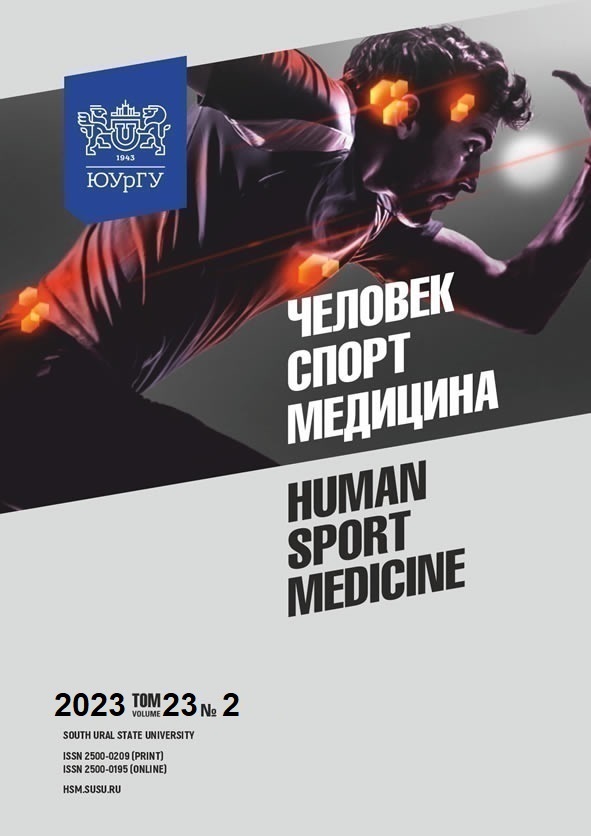DYNAMICS OF PHYSICAL FITNESS IN SPECIAL MEDICAL GROUP STUDENTS AFTER THE USE OF SPORTS BOARD GAMES
Abstract
Aim. The purpose of the research was to study the effect of a method that includes sports board games on the physical development of students in special medical groups. Materials and methods. A unified, comprehensive method was developed and introduced into training to improve physical qualities in students. The study involved 406 students (17–20 years old). The experiment consisted of three stages. At each stage, physical qualities were measured with the following tests: standing long jump; vertical ball throw, seated forward bend, and ruler drop test. The descriptive statistics for each stage of the experiment were provided by the arithmetic mean, the Student’s t-test, and percentage growth. Results. The data obtained during the experiment show the effectiveness of the method for male and female 1 or 2-year students. In the experimental group, percentage growth was 2 times higher on average for all parameters. Conclusion. The conducted research demonstrated that this technique was suitable for students with various health conditions and improved the development of their physical qualities.
References
2. Минёнок, Е.В. Адаптивное физическое воспитание как средство укрепления здоровья студентов специальных медицинских групп / Е.В. Минёнок, О.Ю. Лутковская // Вестник Полоцкого гос. ун-та. Серия Е. Пед. науки. – 2019. – № 15. – С. 159–162.
3. Мониторинг состояния здоровья и физической подготовленности студентов как методология анализа и оценки продуктивности процесса физического воспитания / Е.В. Готовцев, Г.Н. Германов, Ю.В. Романова, И.В. Машошина // Ученые записки ун-та им. П.Ф. Лесгафта. – 2012. – № 1 (83). – С. 40–45.
4. Результаты экспериментальной методики применения статодинамических упражнений на занятиях физической культурой со студентами специальных медицинских групп / В.С. Попереков, Н.В. Булдакова, М.П. Бандаков и др. // Человек. Спорт. Медицина. – 2018. – Т. 18, № 3. – С. 120–134. DOI 10.14529/hsm180312
5. Рютина, Л.Н. Концепция физической культуры для студентов с ослабленным здоровьем / Л.Н. Рютина, А.М. Мацейканец // Colloquium-journal. – 2019. – № 9–4 (33). – С. 58–60.
6. Толистинов, Б.Г. Интерактивные подходы в технологии формирования потребности в самостоятельной физкультурной активности у студентов специальных медицинских групп / Б.Г. Толистинов, Е.И. Шеенко // Человек. Спорт. Медицина. – 2019. – Т. 19, № 3. – С. 88–95. DOI: 10.14529/hsm190311
7. Bray, S.R. Transition to university and vigorous physical activity: implications for health and psychological well-being during transition to university life / S.R. Bray, H.A. Born // J Am Coll Health. – 2004. – No. 52. – P. 11–15. https://pubmed.ncbi.nlm.nih.gov/15018429/
8. Haegele, J. Barriers and facilitators of physical education participation for students with disabilities: an exploratory study / J. Haegele, X. Zhu, S. Davis // International Journal of Inclusive Education. – 2017. – No. 22 (2). – P. 181–188. DOI: 10.1080/13603116.2017.1362046
9. Mohammadi, E. The relationship between body composition, anthropometry, and physical fitness in female university students / E. Mohammadi, A. Saberi // Trends in sport sciences. – 2016. – Vol. 3 (23). – P. 155–158.
10. Pistlova, L. Physical development and general motor performance of Bratislava university students / L. Pistlova, G. Balint, J. Sedlacek // Procedia – Social and Behavioral Sciences. – 2014. – P. 234–246.
11. Viktorov, D.V., Korneyeva, S.V. Actualization of the professionally applied physical training of students with disabilities / D.V. Viktorov, S.V. Korneyeva // European Journal of Physical Education and Sport. – 2018. – No. 6–1. – P. 31–37.
References on translit
1. Golubyatnikova M.V., Yakovleva V.N., Makarova L.N., Ageyeva M.V. [Influence of Physical Exercises on Indicators of the Coefficient of Health, Physical Fitness, Physical Condition and Work Capacity of Students in the Process of Physical Culture Lessons]. Sportivnaya meditsi-na: nauka i praktika [Sports Medicine. Science and Practice], 2017, vol. 7, no. 3, pp. 14–21. (in Russ.) DOI: 10.17238/ISSN2223-2524.2017.3.142. Minenok E.V., Lutkovskaya O.Yu. [Adaptive Physical Education as a Means of Strengthen-ing the Health of Students of Special Medical Groups]. Vestnik Polotskogo gosudarstvennogo universiteta. Seriya E. Pedagogicheskiye nauki [Bulletin of the Polotsk State University. Series E. Pedagogical Sciences], 2019, no. 15, pp. 159–162. (in Russ.)
3. Gotovtsev E.V., Germanov G.N., Romanova Yu.V., Mashoshina I.V. [Monitoring the State of Health and Physical Fitness of Students as a Methodology for the Analysis and Evaluation of the Productivity of the Process of Physical Education]. Uchenyye zapiski universiteta im. P.F. Lesgafta [Scientific Notes of the P.F. Lesgaft University], 2012, no. 1 (83), pp. 40–45. (in Russ.) DOI: 10.5930/issn.1994-4683.01.83.p40-45
4. Poperekov V.S., Buldakova N.V., Bandakov M.P. et al. Results of the Experimental Methodology for the Use of Static-Dynamic Exercises in Physical Education Classes with Students of Special Medical Groups. Human. Sport. Medicine, 2018, vol. 18, no. 3, pp. 120–134. (in Russ.) DOI: 10.14529/hsm180312
5. Ryutina L.N., Matseykanets A.M. The Concept of Physical Culture for Students with Poor Health. Colloquium-Journal, 2019, no. 9–4 (33), pp. 58–60. (in Russ.)
6. Tolistinov B.G., Sheyenko E.I. Interactive Approaches in the Technology of Forming the Need for Independent Physical Activity Among Students of Special Medical Groups. Human. Sport. Medicine, 2019, vol. 19, no. 3, pp. 88–95. (in Russ.) DOI: 10.14529/hsm190311
7. Bray S.R., Born H.A. Transition to University and Vigorous Physical Activity: Implications for Health and Psychological Well-Being During Transition to University Life. Journal American Coll Health, 2004, no. 52, pp. 11–15. DOI: 10.3200/JACH.52.4.181-188
8. Haegele J., Zhu X., Davis S. Barriers and Facilitators of Physical Education Participation for Students with Disabilities: an Exploratory Study. International Journal of Inclusive Education, 2017, no. 22 (2), pp. 181–188. DOI: 10.1080/13603116.2017.1362046
9. Mohammadi E., Saberi A. The Relationship between Body Composition, Anthropometry, and Physical Fitness in Female University Students. Trends in Sport Sciences, 2016, vol. 3 (23), pp. 155–158.
10. Pistlova L., Balint G., Sedlacek J. Physical Development and General Motor Performance of Bratislava University Students. Procedia – Social and Behavioral Sciences, 2014, pp. 234–246.
11. Viktorov D.V., Korneyeva S.V. Actualization of the Professionally Applied Physical Training of Students with Disabilities. European Journal of Physical Education and Sport, 2018, no. 6–1,
pp. 31–37. DOI: 10.13187/ejpe.2018.1.31
Copyright (c) 2023 Human. Sport. Medicine

This work is licensed under a Creative Commons Attribution-NonCommercial-NoDerivatives 4.0 International License.















